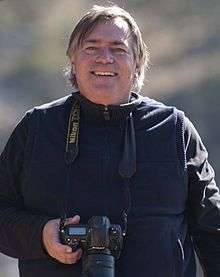Clive Finlayson
Prof. Clive Finlayson MBE FLS (born 15 January 1955) is a Gibraltarian zoologist, paleoanthropologist and paleontologist. He is the incumbent Director of the Gibraltar Museum.[1] Finlayson has published various works mainly based on his research which includes ongoing excavations at Gorham's Cave in Gibraltar, the last known site of the Neanderthals.[2]
Clive Finlayson | |
|---|---|
 Professor Clive Finlayson in 2012 | |
| Born | 15 January 1955 |
| Nationality | British |
| Citizenship | Gibraltarian |
| Alma mater |
|
| Known for |
|
| Spouse(s) | Dr. Geraldine Finlayson |
| Awards |
|
| Scientific career | |
| Fields | |
| Institutions | Gibraltar Museum |
| Thesis | The ecology and behaviour of closely related species at Gibraltar (with special reference to swifts and warblers) (1979) |
Education
Clive Finlayson was born on Gibraltar on 15 January 1955. He has an elder brother, Tommy Finlayson. The Finlaysons are of Scottish descent, but they have been on the Rock since the early 19th century.[3] Clive Finlayson was educated at the Gibraltar Grammar School. He completed a BSc Special Honours degree in Zoology at the University of Liverpool in 1976. In 1980 he graduated with a Doctorate of Philosophy (DPhil) from Oriel College, Oxford and later went on to obtain an MSc in Museum Studies from Leicester University.[4]
Career
Shortly after graduating from his degree, Finlayson became increasingly active within local natural and cultural heritage circles. He founded the Gibraltar Ornithological & Natural History Society (GONHS) in 1978, an organisation which he chaired until 1992. He was also a trustee of the Gibraltar Heritage Trust from 1987 to 1989.[4]
Having been the Managing Director of the Gibraltar Tourism Agency, he took up the position of Director of the Gibraltar Museum in 1991 which he holds to date (June 2012)[1] and is also the Director of the Gibraltar Culture and Heritage Agency's Heritage Division.[2]
In 2001 Finlayson was appointed to the staff of the Department of Anthropology at the University of Toronto. He was made MBE in the 2003 New Year Honours.[2]
His various publications include literature on the Neanderthals and Modern Humans as well as on ornithology and his research programme includes ongoing excavations at Gorham's Cave, the last known site of the Neanderthals, as part of the Gibraltar Caves Project.[2] Finlayson's 2009 book on Neanderthals and their interaction with Homo sapiens expands on the idea that we were the same species since modern man contains genetic sequences that are shared with neanderthals and the possibility of interbreeding is likely. However, Finlayson discusses that because these shared genetic sequences are common across the globe then it is possible that these shared genes are due to our common heritage in Africa.[5]
Along with his many varied roles, he also acts as a consultant to the UNESCO World Heritage Centre in Paris.[1]
Fellowships and awards
- 1976, Recipient of the first David Lack Studentship awarded by the British Ornithologists' Union.[4]
- 1990, Fellow of the Linnean Society of London.[4]
- 2001, Adjunct Professor, Department of Anthropology University of Toronto
- 2003, Awarded MBE in The Queen's New Year Honours.[4]
- 2010, Elected member of Academia Europaea
- 2019, Bestowed Gibraltar Medallion of Distinction
- 2019, Beacon Professor, University of Gibraltar
Publications
Authored
- Finlayson, Clive (2019). The Smart Neanderthal: Bird catching, cave art & the cognitive revolution. Oxford: Oxford University Press. ISBN 9780198797524.
- Finlayson, Clive (2014). The Improbable Primate: How Water Shaped Human Evolution. Oxford: Oxford University Press. ISBN 9780199658794.
- Finlayson, Clive (2011). Avian Survivors: Climate Change and the History of the Birds of the Western Palearctic. T. & A. D. Poyser. ISBN 0713688653.
- Finlayson, Clive (2010). Birds of the Strait of Gibraltar. Poyser. ISBN 1408136953.
- Finlayson, Clive (2009). The Humans Who became extinct: Why Neanderthals Died Out and We Survived. Oxford: Oxford University Press. ISBN 0199239193.
- Finlayson, Clive (2009). Neanderthals and Modern Humans: An Ecological and Evolutionary Perspective. Cambridge University Press. ISBN 0521121000.[6]
- Finlayson, Clive (2007). Al-Andalus. Santana Books. ISBN 8489954690.
- Finlayson, Clive (1993). Prion Birdwatchers' Guide to Southern Spain and Gibraltar. Prion. ISBN 1871104033.
Co-authored
- Finlayson, Clive; Finlayson, Geraldine; Finlayson, Stewart (2017). LOST WORLD: Secrets of a World Heritage Site. Gibraltar: Gibraltar Museum.
- Finlayson, Clive; Finlayson, Geraldine; Finlayson, Stewart (2013). A Guide to Wild Spain, Portugal and Gibraltar. Mijas Pueblo: Santana Books. ISBN 978-84-89954-97-7.
- Where the Last Neanderthals Lived: A Study of Neanderthal and Modern Human Behavioural Ecology in a Glacial Refugium. Oxbow Books. 2012. ISBN 1842172654.
- The Fortifications of Gibraltar 1068–1945. Osprey Publishing. 2006. ISBN 1846030161.
- Birds of Iberia. BookLink Distribution. 2006. ISBN 978-84-89954-28-1.
- Finlayson, Clive & Geraldine (1999). Gibraltar at the end of the Millennium: A Portrait of a Changing Land. Gibraltar: Aquila Services.
- Finlayson, Clive; Cortes, John E. (1988). The Flowers and Wildlife of Gibraltar. Ashford,Buchan & Enright. ISBN 0948466073.
References
- "Clive Finlayson". Osprey Publishing. Archived from the original on 7 November 2012. Retrieved 25 June 2012.
- "Clive Finlayson". My.andalucia.com. Archived from the original on 2 January 2013. Retrieved 25 June 2012.
- Leguineche, Manuel (2002). Gibraltar (in Spanish). Barcelona: Planeta. p. 261. ISBN 84-08-04470-2.
- "Clive Finlayson". Gibraltar Museum. Archived from the original on 8 October 2012. Retrieved 25 June 2012.
- Finlayson, Clive (11 May 2010). "To mate, or not to mate: The Neanderthal question". Viewpoint on BBC News. BBC. Retrieved 7 July 2012.
- Smith, Peter K. (2006). "Rev. of Finlayson, Neanderthals and Modern Humans". Anthropos. 101 (1): 269–70. JSTOR 40466650.